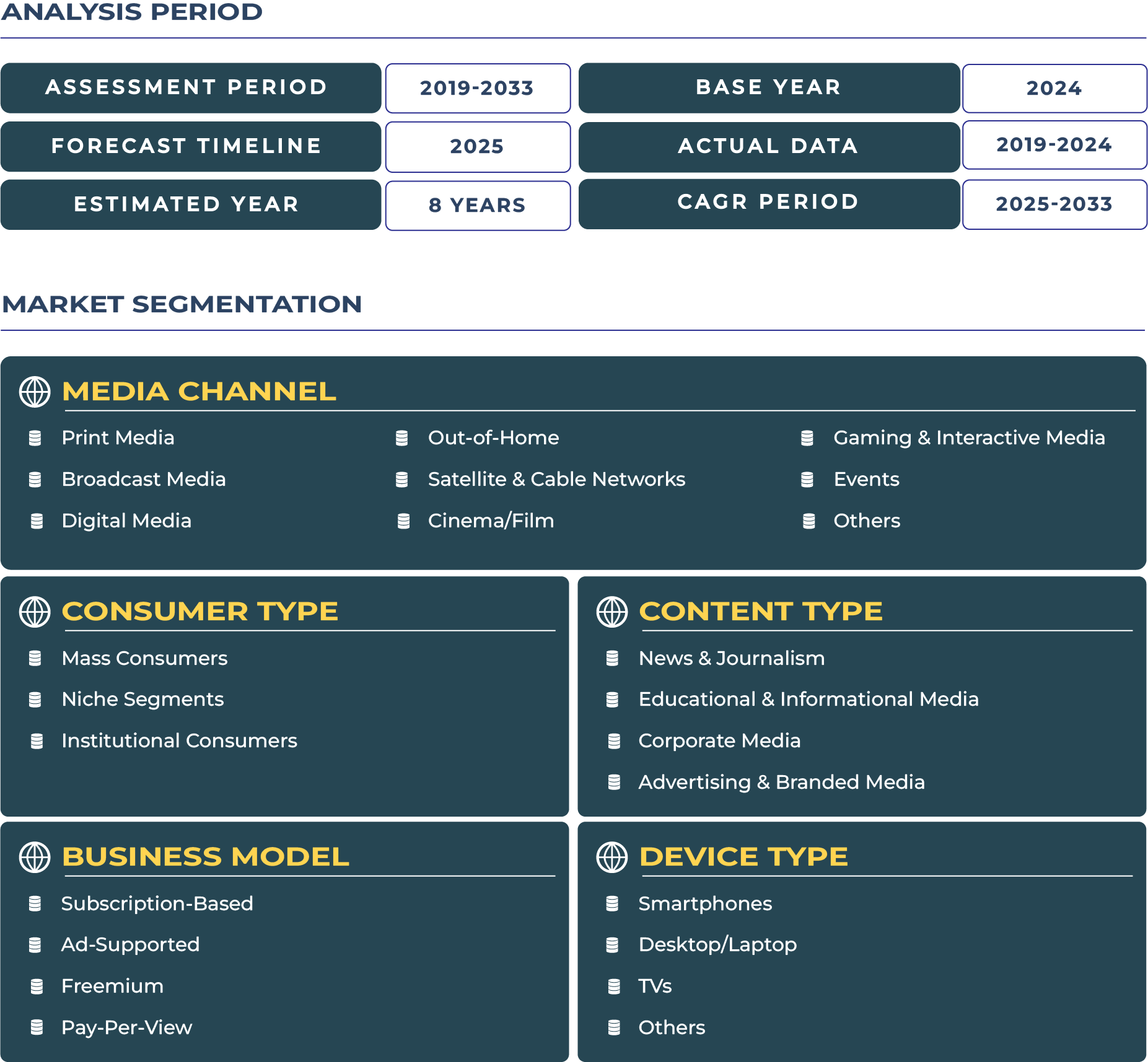Thailand Media Market Growth and Performance
- The Thailand media market size is estimated to reach US$ XX.80 million by the conclusion of 2025.
- This projection indicates a CAGR of X.41% between 2025 and 2033, Thailand media market value reaching US$ XX.61 million by 2033.
Thailand Media Market Outlook
Shifting from Traditional Roots to Digital Realities
The Thailand media industry in 2025 is at a dynamic crossroads. Digital innovation, shifting economic patterns, and audience fragmentation have redefined how content is created, consumed, and monetized. While legacy platforms such as digital TV and traditional newspapers continue to experience revenue declines and organizational restructuring, digital media ecosystems are booming—led by social media platforms, content creators, and influencer-driven content. In 2024, several digital TV channels in Thailand had to downsize operations due to persistent advertising revenue losses, reflecting the urgency for adaptation in the evolving media landscape.
Disposable income in Thailand, averaging around US$7,800 per capita, is giving rise to a digitally active middle class that values on-demand, mobile-first experiences. However, the number of paid users and Average Revenue Per User (ARPU) remain relatively modest compared to regional benchmarks. Consumers are cautious about premium subscriptions, favoring freemium content and ad-supported platforms instead. Consequently, media brands are aggressively optimizing ad models and incorporating data-driven personalization to retain users and boost engagement.
Meanwhile, Thailand’s media export revenue is showing signs of growth, thanks to increased visibility of Thai dramas, music, and short-form content on platforms like YouTube and Netflix. Global audiences, especially in ASEAN countries, are increasingly engaging with Thai content, expanding its cultural reach and commercial potential.
The Rise of Niche Media and Mobile-Centric Audiences
The Thailand media sector is increasingly defined by niche content and segmented audience strategies. Consumers are favoring specific genres such as pets, finance, history, and personal development—areas previously underrepresented in mainstream media. Influencers and independent creators have capitalized on these verticals, building tightly knit communities that offer advertisers high conversion potential due to trust and relevance.
Demographically, Gen Z and Millennials dominate Thailand’s digital media consumption. These groups, raised in a connected world, demand personalized, immersive, and interactive content experiences. Platforms such as Facebook, TikTok, LINE, and YouTube are thriving due to their adaptability and integration of shopping, entertainment, and news—an alignment with Thai consumers’ multitasking media habits.
Social media isn’t just a distribution tool—it is a media platform in itself. More than 60% of internet users in Thailand make online purchases weekly, and a significant share admits their buying decisions are directly influenced by social media content. This trend has elevated the role of influencers and digital creators, who are now rivaling traditional news outlets in engagement and reach.
Media Consumption Habits
Local content remains king in Thailand. Thai consumers prefer media in their native language and culturally resonant storytelling. This cultural alignment drives the success of Thai dramas on both domestic TV and international platforms like Netflix. In Q1 2025, Netflix partnered with local studios to release three Thai-original web series that trended in multiple Southeast Asian markets, showcasing the power of regional storytelling.
Consumer habits are increasingly shaped by anytime-anywhere access. Streaming platforms, mobile apps, and voice-activated assistants are influencing when and how content is consumed. This mobile-first behavior is especially pronounced among urban youth, who prefer video, short-form content, and live interactions over long-form reads or traditional broadcasts.
Major media brands like Workpoint TV, Channel 3, and The Standard are evolving to stay relevant. While traditional networks are expanding their digital presence through YouTube channels and OTT apps, digital-native players focus on AI-based personalization, influencer partnerships, and real-time analytics. Global brands, though restricted by foreign ownership limits, are collaborating with local content creators to gain traction. YouTube, for instance, launched a Thailand Creator Incubator in late 2024 to support ethical storytelling and sustainable monetization models among local talent.
The Thailand Media Industry Ecosystem: A Future Defined by Creator-Led Innovation
The Thailand media industry ecosystem in 2025 is driven by a new media economy where creators, not corporations, command consumer attention. From lifestyle vloggers to independent news commentators, creators have built engaged follower bases that seamlessly translate into offline influence, merchandise, and even event-based revenue. However, this decentralization of media raises questions about ethics, fact-checking, and regulation, especially as creators increasingly cover sensitive topics and news.
To stay competitive, traditional players must redefine their go-to-market strategies—focusing on creator partnerships, branded content, and hybrid subscription models. Customer acquisition now hinges on community building, content authenticity, and data-backed personalization. As the Thai media landscape continues to evolve, the success of its players will be determined by their ability to embrace digital disruption, localize content strategies, and co-create with the influencer economy—marking a new era of engagement-led media growth.
Thailand Media Market Scope







